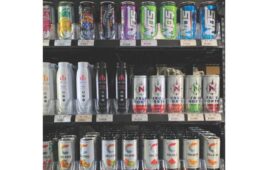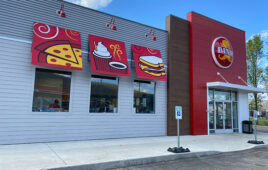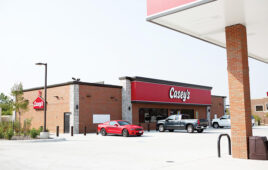How to stay ahead in an ever changing industry.
By Matt Lauck, Emerson Climate Technologies
Convenience stores have historically been known for selling packaged foods, cigarettes and cold beverages. Today, convenience stores are evolving to become foodservice destinations. This is a result of busy consumers wanting fresh, ready-to-eat meal solutions faster. For convenience store operators, this brings new customers inside the store—and the potential for higher profits. But, incorporating foodservice adds complexity.
In order to truly maximize the potential of their stores, there are three critical strategies that retailers should consider as part of their foodservice initiative: 1.) change customer perceptions, 2.) drive enterprise consistency and 3.) implement best practices. By investing in facilities, equipment knowledge and procedures, the potential for success goes up as convenience stores quickly automate operations and stay ahead in this rapidly changing industry.
Change Customer Perceptions
To stay competitive, the customer perception of food quality in convenience stores needs to change. Operators need to think about how they can use their stores’ systems to enhance the building environment, ultimately providing a better shopping experience. They can accomplish this through the application of facility management systems with remote monitoring capabilities. Such systems can play a critical role in creating a comfortable shopping experience through the optimization of lighting, HVAC and refrigeration systems. With so much being invested in designing and developing new store prototypes, it is in the best interest of the operator to ensure that stores are performing as expected.
While facility management systems are new to the convenience store industry, these systems have long been utilized in other retail channels that also deliver food product to consumers. Consumers don’t think twice about the quality or how product temperature is maintained in a supermarket; they tend to view supermarkets as the place where they can confidently shop for their families. This same technology and insight can be used to enhance convenience store foodservice and change the consumer’s perception so that convenience also builds a reputation for inviting, safe stores and quality food.
Drive Enterprise Consistency
Having multiple locations spread out geographically adds its own level of complexity to any operation. Replication is key to developing a brand experience across all stores while simultaneously controlling operational costs—especially when it comes to food. By removing operational inefficiencies, inconsistencies and unnecessary costs from store operations, operators can redirect those wasted dollars to more productive pursuits. Consistency and early detection of problems also help retailers protect the brand. In the world of Facebook and Twitter, the last thing an operator wants to hear is that a consumer found a refrigerated case with product for sale at the wrong temperature. Facility management systems can detect such faults before a minor repair becomes a major public relations nightmare.
Consistently monitoring store systems across the enterprise helps with the continued brand development convenience stores need to be successful with a foodservice initiative.
Convenience store executives can’t be onsite at every store every day; facility controls combined with remote services and software tools alert them to issues long before they are perceived by consumers, or even store employees. With enterprise-wide visibility through remote monitoring that connects lighting, refrigeration and heating systems, operators can identify issues from anywhere in the enterprise—and many times, resolve them remotely. This remote resolution also results in fewer unnecessary service calls and costs.
Implement Best Practices
Routinely, convenience store staff is tasked with manually collecting temperature data, which is inaccurate and time consuming. Keeping staff in front customers is best. Every minute staff spends managing operational tasks leaves customers waiting. And the less skill and expertise store personnel has, the longer it takes to resolve issues. In an environment where turnover is high and staffing is limited, you can’t train your way out of this problem. Operators need to make tough decisions on where staff should spend their time, finding ways to remove operational responsibilities that distract them from serving customers should be a priority.
With facility controls, convenience stores can monitor food quality automatically, simplify systems management and solve problems quicker. Relying on a store manager to walk around with a clipboard to measure temperature levels and defrost schedules is error-prone and sometimes neglected—especially during peak business hours when customers demand all of their attention. With food quality automation and store insight from remote monitoring, store staff can separate routine notifications from those issues that will actually impact customers, take food quality data collection activities out of the hands of store associates and create an audit trail. Store staff will spend less time worrying about regulatory compliance, reports and equipment operations, and spend more time building value and preference in the eyes of customers.
This too can be achieved through the application of an integrated facility management system that provides retailers with a single portal to check on the status of their entire chain at a glance. Operators can manage the complexity of their operations from a centralized location to make operations more efficient, consistent and valuable throughout their enterprise. As a result, customers will come to expect and receive the same high quality experience across every store, which will keep them coming back.
Conclusion
The convenience store industry is changing, and in order to stay ahead in such a competitive environment as foodservice, convenience store leaders will need to think differently about store operations. They will look to automate operations that drive consistent delivery of high quality food in a welcoming environment for consumers.
Author Bio:
Matt Lauck is the small format business development director at Emerson Climate Technologies Retail Solutions. Matt has worked with various convenience store, box and supermarkets in his 18-year career with Emerson.
Emerson Climate Technologies specializes in technologies that provide global solutions to improve human comfort, safeguard food and protect the environment. To learn more about facility management systems and site monitoring services for convenience store, box and supermarket facilities, visit www.emersonclimate.com/retailsolutions.




